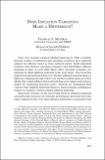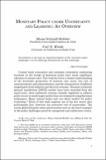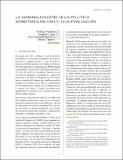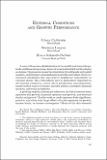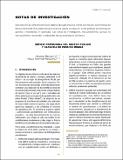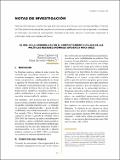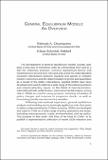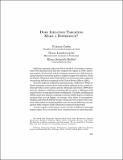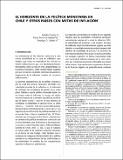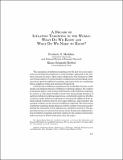Search
Now showing items 1-10 of 22
Does inflation targeting make a difference?
Since New Zealand adopted inflation targeting in 1990, a steadily growing number of industrial and emerging economies have explicitly adopted an inflation target as their nominal anchor. Eight industrial countries and thirteen emerging economies had full-fledged inflation targeting in place in early ...
Monetary policy under uncertainty and learning: an overview
Central bank economists and academic economists conducting research on the design of monetary policy have made significant advances in recent years. This work has led to a clearer understanding of the desirable properties of interest rate rules, the role of announcements and communication, and the ...
La nominalización de la política monetaria en Chile: una evaluación
En agosto del 2001, el Banco Central de Chile 'nominalizó' su principal instrumento de política monetaria, reemplazando la tasa de política monetaria (TPM) indizada a la Unidad de Fomento, que usaba hasta la fecha, por una TPM nominal o denominada en pesos. Una serie de consecuencias, tanto en la ...
External conditions and growth performance
A central dimension of globalization is the world trend toward larger trade and financial openness, observed in most industrial and developing economies. Openness increases the integration of world goods and capital markets, contributing to potential gains in growth and welfare. However, increased ...
Déficit previsional del sector público y garantía de pensión mínima
Un objetivo de una reforma profunda de los sistemas de pensiones de reparto — aunque ciertamente no el único — es co rregir el desequilibrio fiscal que frecuentemente está asociado a dichos esquemas. Por eso, las reformas pensiónales profundas típicamente
combinan una reducción de los beneficios netos ...
El rol de la credibilidad en el comportamiento cíclico de las políticas macroeconómicas: evidencia para Chile
La literatura empírica, incluso la más reciente, ha sostenido que las políticas monetaria y fiscal en economías emergentes,especialmente en América Latina, son procíclicas, contribuyendo de esta forma a agrandar las fluctuaciones del ciclo económico. Se argumenta tradicionalmente que los países de ...
General equilibrium models: an overview
The development of general equilibrium models (GEMs) goes back a long way in economics, both at a theoretical level and as a tool for empirical analysis. General equilibrium theory and modeling have proved to be relevant and useful for understanding economic interactions between markets and agents in ...
Does inflation targeting make a difference?
Inflation targeting is the new kid on the block of monetary regimes. Since New Zealand and Chile first adopted the regime in 1990, a growing number of industrial and developing countries have followed suit, anchoring their monetary policy to explicit targets for inflation.
El horizonte de la política monetaria en Chile y otros países con metas de inflación
La tolerancia a cierta volatilidad en la tasa de inflación lleva a que aquellos países que tienen metas de inflación diseñen su política monetaria de modo que refleje flexibilidad en cuatro dimensiones: el índice de precios para el cual se define la meta, el ancho del rango meta, el punto medio del ...
A decade of inflation targeting in the world: what do we know and what do we need to know?
The emergence of inflation targeting over the last ten years represents an exciting development in central banks' approach to the conduct of monetary policy. After initial adoption by New Zealand in 1990, a growing number of central banks in industrial and emerging economies have opted for inflation ...

